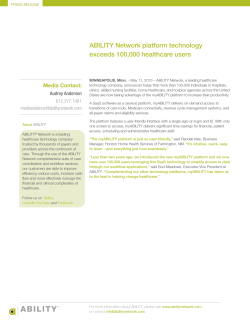
The bigger value picture behind Cardinal Health`s Cordis buy
INTERVIEW: The bigger value picture behind Cardinal Health’s Cordis buy Clinica provides you with up to the minute coverage and opinion on company, product, market and regulatory developments as well as market size, growth and sales forecasts. 1• • • www.clinica.co.uk Reprinted by Clinica (www.clinica.uk.co). Unauthorized photocopying prohibited. INTERVIEW: The bigger value picture behind Cardinal Health’s Cordis buy Tina Tan– April 10, 2015 When Johnson & Johnson agreed to sell Cordis to Cardinal Health for nearly $2bn last month, many saw Cardinal Health taking on a portfolio of mature medical devices – albeit of a well-established and globally recognized brand – that did not offer that much differentiation from the competition. So what’s in it for Cardinal Health and what’s the overriding objective behind the move? Tina Tan speaks to Don Casey, CEO of Cardinal Health’s Medical Segment, who spent nearly 26 years at J&J, to find out more about the underlying market changes and the strategy that motivated the company to make not only this particular Don Casey acquisition, but likely more similar deals in the future In order to succeed in today’s budget-constrained healthcare environment, suppliers of medical devices are learning to push the value message to their customers. For the likes of Medtronic, Johnson & Johnson and their medtech peers, this value comes from offering innovative products designed to bring benefits to patients and physicians, which then translate into cost efficiencies for the healthcare provider in terms of quicker procedure times, fewer complications, faster recovery and shorter hospital stay. Cardinal Health, however, is taking a different angle with its value message by focusing on innovative ways to improve the distribution and supply of products to healthcare providers, and thus bring about cost efficiencies, rather than to focus on innovative products per se. 2• • • “Demographic trends show that we are seeing an aging population [and this is] creating a greater demand for healthcare all around the world. But with that greater demand, many places are not necessarily seeing a commensurate interest in investing in healthcare – whether it’s from governments or private payers – so we have to learn how to do more with the same amount of money,” Don Casey, CEO of Cardinal Health’s Medical Segment, tells Clinica. This, says Mr Casey, has put pressure on Cardinal Health and other medical device manufacturers to not only deliver highquality products that can be used efficiently, but deliver them efficiently to allow for greater patient care. “When we look at medical devices, whether it is in Europe, Asia or the US, there hasn’t been a great deal of investment in the infrastructure of delivery systems and Reprinted by Clinica (www.clinica.co.uk). Unauthorized photocopying prohibited. hospital or surgery center would see probably in the range of 8-15% savings on their sides,” says Mr Casey. For Cardinal Health, this technology is an integral part of its physician preference item (PPI) strategy which it has been pursuing the last few years as a major growth platform. The company’s recent M&A activity reflect this strategy, like the $1.9bn deal it signed last month to acquire Johnson & Johnson’s interventional cardiology business Cordis. A pioneer in the stent market, Cordis has established a solid reputation in the interventional cardiology space but is now, nonetheless, a mature, slow-growing business. While recognizing that Cordis’ portfolio of cardio- and endovascular products brings limited clinical differentiation, the devices fit the PPI bill: products that are typically the costliest for the healthcare providers not only because of high physician preference and usage, but also because they are most prone to waste and loss, and therefore have the biggest potential for cost savings. INCRAFT® AAA Stent Graft System creating information-driven supply chains. We’re going to invest millions of dollars around creating information enablement through the use of RFID technology – whether it’s in the cath lab or other healthcare institutions. This will be a shared resource for the entire industry and allow a much more information-enabled transaction loop,” says the CEO. This RFID technology that Mr Casey is referring to comes courtesy of WaveMark, which Cardinal Health acquired in 2013. Simply put, the technology works by tagging a medical device with an RFID chip, which gives the device a unique identifier and holds information such as its expiration date and details of its location – for example, if it is in a warehouse and which warehouse; when the device arrives at a hospital or ambulatory care center; when it is in an operating room; when it is withdrawn from the cabinet that it is placed in; and when the device has been used. Cardinal Health already has some compelling figures to back claims about the cost-efficiencies this informationenabled system can bring. “This system has been used predominantly in the Veterans Affairs hospitals within the US but there are six other institutions. And what they’ve seen are inventory holding cost reduction of between 5-10%, aggregate inventory reduction levels of 5%, expired products completely eliminated and lost product completely eliminated. So in aggregate, we believe that 3• • • By leveraging its RFID-enabled supply chain capabilities, Cardinal Health believes it can continue to see growth and get more mileage from mature, but well-respected products such those offered by Cordis. “J&J and [chairman and CEO] Alex Gorsky have been articulate about their need to focus on investing in innovation and be technology-driven and they would like to be leaders in that category – Cordis didn’t necessarily fit that model so the business was not really a priority,” says Mr Casey, who had spent 26 years at J&J before joining Cardinal Health in 2012. “By comparison, Cordis in Cardinal’s portfolio will become a major priority…From this transaction, we can bring a different perspective into the market.” Mr Casey foresees more potential acquisition targets further ahead that fit into Cardinal Health’s PPI strategy, as companies such as J&J continue to balance their portfolio and “focus aggressively on innovation”. “That creates a different set of market dynamics that we hope to take advantage of,” he tells Clinica, adding that Cardinal Health would keep a lookout for both product and service acquisitions. “I’ve been in healthcare for over 30 years. Healthcare is changing faster today than any time in the past – a lot of the traditional ways of going to market and approaches to delivering medical devices as well as services in the healthcare environment are going to change and continue to change as the system looks to meet the demand created by an aging population and increase in chronic illnesses. It will spawn a lot of innovation in terms of products but also innovation in terms of service models and analytics. We think Cardinal Health can play a very important role there.” Reprinted by Clinica (www.clinica.co.uk). Unauthorized photocopying prohibited.
© Copyright 2025

















